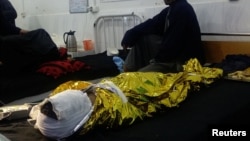LASHKAR GAH, Afghanistan -- Officials and residents in the restive southern Afghan province of Helmand say scores of civilians have been killed in air strikes.
Ahmadullah, who goes by one name only, says aircraft began to circle over their village, Zanzeri Drab, in Helmand’s rural Gramsir district late on November 27.
“First the helicopters arrived, and they began circulating overhead. Then the jet aircraft targeted one of the houses in the village,” he told Radio Free Afghanistan on November 28.
“Some 30 members of one family were killed in the bombing,” he said while accompanying a teenage victim of the bombing in a hospital in the provincial capital, Lashkar Gah. “The bombing wiped out the entire family, and this child is the only survivor. He was visiting his maternal uncles that day.”
Ahmadullah says the victims included children as young as three months old and many women. “Three men were killed, but they were farmers and were not involved in militancy,” he said.
Another resident, Feda Mohammad, was quoted by Reuters as saying some victims were still buried in the rubble of the compound. "The area is under the control of the Taliban, but all of the victims of last night's bombing are civilians," he said.
NATO-led forces in Afghanistan said Afghan government troops and their U.S. advisers called an air strike after coming under fire from Taliban fighters in a compound in Garmsir.
"At the time of the strike, the ground force was unaware of any civilians in or around the compound; they only knew that the Taliban was using the building as a fighting position," said a statement by the NATO forces. "We investigate every credible allegation of error and review every mission to learn, adapt, and improve."
Mohammad Yasin Khan, the governor of Helmand, says forces called in air strikes as they battled the insurgents.
“The enemy wanted to attack our forces while one of their commanders was trying to escape in his car,” he told journalists on November 28. “An air strike targeted his vehicle; it also damaged some houses. We have learned that some civilians have been killed and injured alongside the enemy fighters, but we still don’t know their exact numbers.”
A purported Taliban spokesman, however, claimed that all the victims of the air strike were civilians and none of their fighters died in the bombing.
The casualties are the latest among a rising death toll by air strikes. In a report last month, the United Nations Assistance Mission in Afghanistan (UNAMA) said air strikes by Afghan and U.S. forces caused 313 deaths and 336 injuries from January to the end of September this year. This number was already the highest in any year since 2009.
Overall, UNAMA found that 2,798 civilians were killed and 5,252 were wounded during the same period. It holds the insurgents responsible for most deaths.
Mounting civilian casualties highlight the increasing severity of the Afghan war as Washington and Kabul push for negotiations with the Taliban.
The number of bombs, missiles, and other weapons also indicates an intensifying air war in the country. U.S. aircraft had released 5,213 weapons by the end of September, according to the U.S. military. This number is up from 4,361 for all of 2017 and the highest number since 2011.
Radio Free Afghanistan correspondent Mohammad Ilyas Dayee contributed reporting from Lashkar Gah Afghanistan. With reporting by Reuters and AP.







